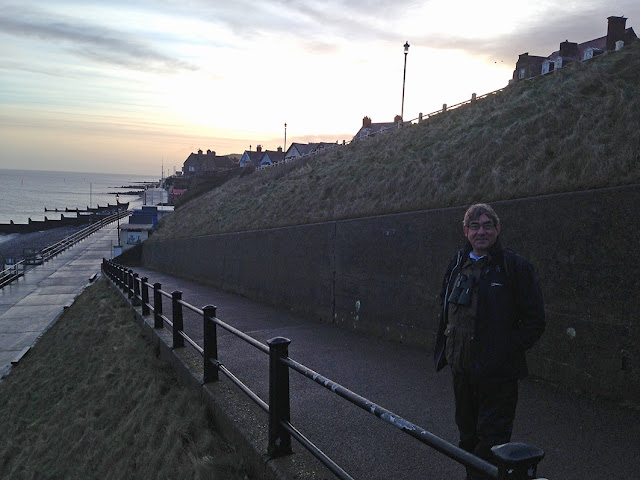Dusky Thrush, Beeley, Derbyshire - 5th December 2016
Late that same night the ID was confirmed and access was arranged, and the following day the bird was seen and reported again in the village. Twitch on! Except, not for me. I was at work and had a stack of stuff to complete before the Christmas break. But, as the morning wore on, and I remembered my frustration at not being able to go and see the last (and only other twitchable) Dusky Thrush in Kent, May 2013, and couldn't focus on work that well. My boss, understanding as ever, let me take the afternoon off, and I was on site by 13:30.
The village was full of cars, although most of the birders were obviously hdden behind wall somewhere, as I couldn't see many. The bird was around the feilds and orchard near Dukes Barn, and just as I arrived a group of three birders ran in from stage left breathlessly saying "it's heading this way". And all of a sudden the bird was there, in a tree in the orchard in front of us, soon dropping into the grass. Pretty lucky on my part, having avoided a long wait, and being at the front when a approximately 150 birders rushed around the corner to join us!
Dusky Thrush, Beeley, Derbyshire - 5th December 2016
The bird fed in the long grass for a round five minutes, seemingly oblivious to the noisy work on the roof of the nearby building. It then flew up and over our heads, out of view.
After taking a coffee from the great Dukes Barn staff, I got some prolonged views of the bird from the adventure playground. It seemed to be trying keep a low profile, so as to avoid winding up the Blackbirds, while going after the same food as them (apples, haws, and worms and other inverts). The Blackbirds clearly didn't appreciate the competition, and the Dusky Thrush had to fight off a couple of attacks. The Redwings kept out of the orchard, preferring to stay in the treetops bordering the nearby fields.
The Dusky Thrush was smaller than the Blackbirds, more like a Song Thrush or Redwing in size and plumage, though perhaps a shade bigger than either of those. The striking aspects of the plumage were the thick supercilium, which widened behind the eye (unlike a Redwing), and the distinctive patterns of the throat, belly and flanks. The underparts had a background colour of an off-white grey, including the think feathering around the tops of the legs The throat was pale, bordered by dark malar stripes and a mottled ring across the upper breast. The belly and flanks had a wonderfully characteristic chessboard pattern.
Solid brown ear coverts, and the same colour on the mantle, though with some streaking. The flight feathers had rusty orange-brown fringes. There appeared to be a pale patch between the wings, and the tail was long and dark on both upper and undersides. The bill was mostly dark, with an orangey base. The legs were dark too.
Dusky Thrush, Beeley, Derbyshire - 5th December 2016
Dusky Thrush notes - 5th December 2016
Credit must go to the staff at Dukes Barn, who were generous with their time and assistance on the day (and throughout the week by all accounts). They even rustled up some food for me when I popped in to say thanks for the twitch and ask about places nearby to get some grub. They got an extra tenner from me for that. After looking at the services they provide, I donated some more online - please consider donating via their page here: Support Dukes Barn.
Seeing this bird obviously made up for missing the last one, with the bonus of it being so much closer to home, and so obliging. I genuinely believed I would never have a another chance to see a Dusky Thrush in the UK after failing to go for the Kent bird. It's been a good year for that sort of thing. I've "gripped back" some great birds this year that I had twitched and dipped previously and had regretted ever since: Brünnich's Guillemot, Great Knot, and the less rare Booted Warbler.
Later the same week, on Sunday 11th, I had a couple of hours at Rodley NR. A quiet morning, but some good views of a male Kingfisher at the dipping pond and then later at the reedbed hide. I counted 85+ Redwing flying over in three groups while I was there, though I reckon there were probably hundreds more. I had a fantastic close encounter with a female Sparrowhawk as it flew on to the Poplar Carr fence right beside where I was stood. A single Red Kite was over Barmley Falls Wood, being mobbed by Jackdaws and performing some wacky manoeuvres. A lovely male Pochard on the lagoon, a smart pair of Goosander on the river, and a couple of adult Herring Gulls on the farmer's field.
Kingfisher, Rodley NR, West Yorkshire - 11th December 2016























































